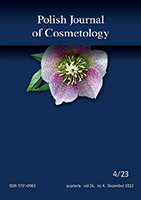search by
Copyright @ Pol J CosmetolMicroalgae oil in o/w emulstion systemsMarta Bareja, Beata W. Domagalska, Katarzyna Pytkowska Wyższa Szkoła Zawodowa Kosmetyki i Pielęgnacji Zdrowia w Warszawie Summary Introduction. Emollients are responsible for the sensory and cosmetic properties of topically applied emulsions. The traditional source of emollients are oilseeds. In recent decades the use in this field of synthetic liquid waxes and silicones was increased. Despite this a search for new emollient raw materials characterized by different functional properties is still ongoing. Aim. The aim of the study was to examine the impact of new oil from microalgae on the stability of the cosmetic emulsion, the sensory evaluation and the instrumental evaluation of selected parameters of the emulsion-treated skin (hydration, greasing, TEWL). Material and methods. In vivo studies cosmetic emulsions containing oils: paraffin, grapeseed, and microalgae were used. Test (measurement of the TEWL, hydration and greasing) was performed on a group of 10 volunteers aged 18-65 years. Also sensory evaluation was performed. Results. All tested emulsions caused change of the tested parameters of the skin in relation to the control area. There were no statistically significant differences between oils in the influence on measurable parameters of the skin. It was found differences in sensory characteristics. Conclusions. The study confirmed that oil from microalgae decrease transepidermal water loss and has a very good greasing and moisturizing effect. The emulsion containing the oil is positively evaluated in sensory analysis. Thus the oil can be used to enrich the set of emollients used in cosmetology. Key words: emollients, TEWL, microalgae oil |




